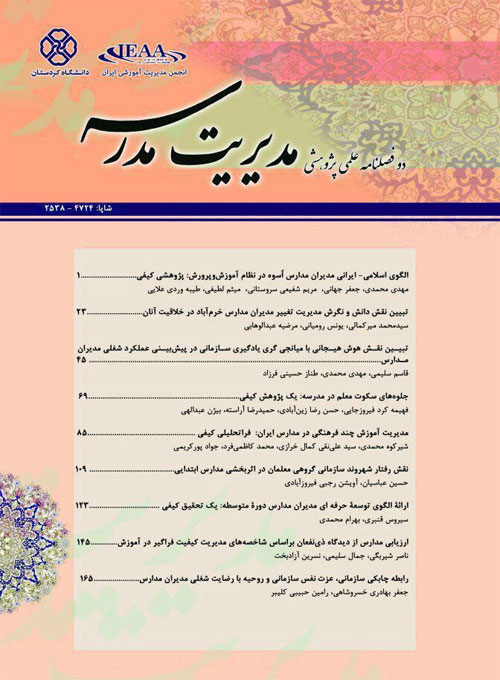The moderating role of learning climate on the impact of quality of school life on student self-efficacy
of this study was to investigate the learning climate moderating role on the quality of school life impact on student's self-efficacy. Quality of life (QOL) is the general well-being of individuals and societies, describing negative and positive features of life. The World Health Organization (WHO) defines the quality of life as "The individual’s perception of their position in life in the context of the culture and value systems in which they live and in relation to their goals. Similar to the other environments and social systems, schools describe as terms of the quality of life which they offer students. The quality of school life (QSL) has been widely investigated and drawn attention to its influence on students' achievement as a critical aspect of schooling. Finally, it can be said that the quality of life in a school combines the positive and negative experiences of emotions associated with different aspects of school life and its consequences. Schools are often described by the quality of their affective and social environments. The QSL refers to students’ personal and experiential general well-being at school which reflect students’ level of satisfaction toward their daily school life. The quality of school life is a multi-faceted concept which goes beyond the transmission of knowledge or the development of learning skills to include structure, teaching, curricula, affective, and social environments. Williams & Batten, (1981) provided three components of QSL: 1) Positive affect which reflects students' general satisfaction with school as a whole; 2) Negative affect which captures students' negative reactions towards school such as feelings of alienation, loneliness, and depression; 3) Satisfaction which consists of curriculum-related and social development factors as two specific dimensions of school. Mok & Flynn, (1997) suggests seven distinct factors to identify QSL as Satisfaction with school; Alienation from school; Relationships with teachers; Students' sense of achievement; Relevance of school; Sense of identity and; Self-esteem and status. One of the most significant motivational factors affecting schooling process is self-efficacy. It is a motivational construct and a key component of social cognitive theory. It refers to individuals’ beliefs in their abilities to perform a task successfully. Self-efficacy is defined as the judgments of people concerning their capacity to perform and organize actions required to attain a predefined performance. It has received ample attention in educational research. It has been shown to predict students' academic achievement across academic areas and levels, college major and career choices (Brown & Lent, 2006), and it is associated with key motivation constructs such as causal attributions, self- concept, optimism, achievement goal orientation, academic help-seeking, anxiety, and value(Usher & Pajares, 2008:751). Another motivational construct which contributes to the student's successful learning and performance is school climate. Freiberg and Stein (1999) described school climate as the heart and soul of a school. It is about that essence of a school that leads a child, a teacher, an administrator, a staff member to love the school and to looks forward to being there each school day (Freiberg & Stein,1999:12). School climate is about that quality of a school that helps each individual feel personal worth, dignity, and importance, while simultaneously helping create a sense of belonging to something beyond ourselves. According to social learning theory and field theory, is the meaningful environment, or the psychological situation, which is the best predictor of a person’s actions (Rotter, 1954). School climate can not only facilitate the student's learning process but also can be a major obstacle to their learning and achievement. The process of globalization and sophisticated technology development are one of the main challenges of the 21st century. Universities and schools to meet these challenges must be able to educate the new generation with high, flexible and creative capabilities. Therefore their performance should serve beyond conventional scientific functions. Thus, one of the most important tasks for school is to create an environment that ensured the wholesome quality of schooling. Variables such as the quality of school life, school & classroom climate, and student's self-efficacy are among the most important.
Data collection tools consisted Anderson & Bourke (2000) Quality of School Life questionnaire, Williams & Deci (1996) learning Climate questionnaire, and Sherer et al (1982) Self-Efficacy Scale. Quality of School Life questionnaire: The revised form of the Anderson & Brock (2000) Quality of School Life questionnaire (QSLQ) was translated into Persian by Soltani Shal et al (2012), and was normalized between Iranian students. This scale consists of 39 items and five subscales: Opportunity; Adventure and achievement; General Satisfaction;Negative Affect and Social Integration; that calculates both the overall and subscales scores separately.
Self-Efficacy Scale: The Sherer et al (1982) self-efficacy scale has two subscales: general self-efficacy (17 items) and social self-efficacy (6 items); that in this study we use general subscales. For that subscale, a sum is calculated by adding the responses to the individual items. Learning Climate Questionnaire (LCQ): Williams & Deci (1996) and Standage, Duda, & Ntoumanis (2005) develop the original and ultimate version of this scale, respectively. This scale (20 item) was translated into Persian by Abdol-Nejad et al (2004), and measures how well participants perceive their needs for autonomy, competence, and relatedness as being met through program participation. Autonomy refers to the ability to make choices and acting in accordance with one’s sense of self. Competence refers to feeling a sense of mastery within one’s environment and experiencing opportunities to display skills. Relatedness refers to a sense of belonging both with other individuals and with one’s community.
The collected data were analyzed based on descriptive indicators such as frequency, mean and percent, Pearson correlation, confirmatory factor analysis and path analysis.
The findings of the study showed that there are a positive and significant correlation between the quality of school life with self-efficacy, quality of school life with learning climate and self-efficacy with the learning climate at the level (p≤0.01). Also, the findings from path analysis coefficients indicate that were positive and direct effect of quality school life on self-efficacy, the learning climate on self-efficacy and quality of school life. In addition, the quality of school life has an indirect effect on self-efficacy and the learning climate in the relationship between that has a moderating role.
- حق عضویت دریافتی صرف حمایت از نشریات عضو و نگهداری، تکمیل و توسعه مگیران میشود.
- پرداخت حق اشتراک و دانلود مقالات اجازه بازنشر آن در سایر رسانههای چاپی و دیجیتال را به کاربر نمیدهد.



